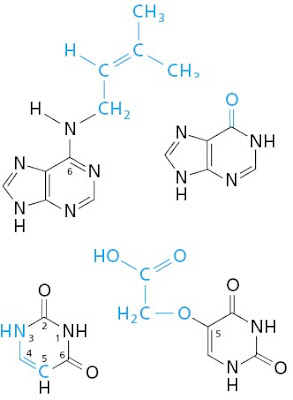 This is an easy one. We talked about this molecule in our lunch time seminar just a few minutes ago. It binds to lots of proteins.
This is an easy one. We talked about this molecule in our lunch time seminar just a few minutes ago. It binds to lots of proteins.Post your answer as a comment. I'll hold off releasing any comments for 24 hours. The first one with the correct answer wins. I will only post mostly correct answers to avoid embarrassment. The winner will be treated to a free lunch with a very famous person, or me.
There could be two winners. If the first correct answer isn't from an undergraduate student then I'll select a second winner from those undergraduates who post the correct answer. You will need to identify yourself as an undergraduate in order to win. (Put "undergraduate" at the bottom of your comment.)
Some past winners are from distant lands so their chances of taking up my offer of a free lunch are slim. (That's why I can afford to do this!)
In order to win you must post your correct name. Anonymous and pseudoanonymous commenters can't win the free lunch.
Winners will have to contact me by email to arrange a lunch date.
UPDATE: The molecule is malonyl-ACP where ACP stands for acyl carrier protein. The winners are Bill Chaney and Matt McFarlane. One other person got it right but didn't specify what "ACP" stood for. The most common error among those who came close was to call it malonyl-CoA.
Winners
Nov. 2009: Jason Oakley, Alex Ling
Oct. 17: Bill Chaney, Roger Fan
Oct. 24: DK
Oct. 31: Joseph C. Somody
Nov. 7: Jason Oakley
Nov. 15: Thomas Ferraro, Vipulan Vigneswaran
Nov. 21: Vipulan Vigneswaran (honorary mention to Raul A. Félix de Sousa)
Nov. 28: Philip Rodger
Dec. 5: 凌嘉誠 (Alex Ling)
Dec. 12: Bill Chaney
Dec. 19: Joseph C. Somody
Jan. 9: Dima Klenchin
Jan. 23: David Schuller
Jan. 30: Peter Monaghan
Feb. 7: Thomas Ferraro, Charles Motraghi
Feb. 13: Joseph C. Somody
March 5: Albi Celaj
March 12: Bill Chaney, Raul A. Félix de Sousa
March 19: no winner
March 26: John Runnels, Raul A. Félix de Sousa
April 2: Sean Ridout
April 9: no winner
April 16: Raul A. Félix de Sousa
April 23: Dima Klenchin, Deena Allan
April 30: Sean Ridout
May 7: Matt McFarlane
May 14: no winner
May 21: no winner
May 29: Mike Hamilton, Dmitri Tchigvintsev
June 4: Bill Chaney, Matt McFarlane




















